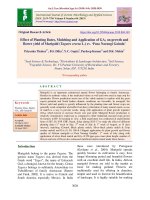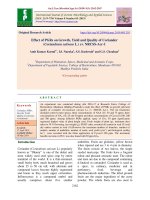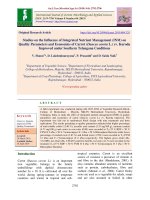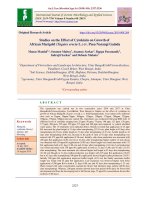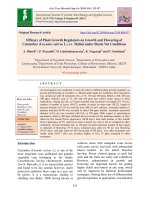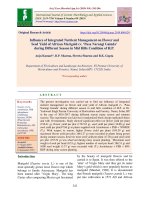Effect of planting dates, mulching and application of GA3 on growth and flower yield of marigold (Tagetes erecta L.) cv. ‘Pusa Narangi Gainda’
Bạn đang xem bản rút gọn của tài liệu. Xem và tải ngay bản đầy đủ của tài liệu tại đây (431.77 KB, 12 trang )
Int.J.Curr.Microbiol.App.Sci (2019) 8(4): 3028-3039
International Journal of Current Microbiology and Applied Sciences
ISSN: 2319-7706 Volume 8 Number 04 (2019)
Journal homepage:
Original Research Article
/>
Effect of Planting Dates, Mulching and Application of GA3 on growth and
flower yield of Marigold (Tagetes erecta L.) cv. ‘Pusa Narangi Gainda’
Priyanka Thakur1*, B.S. Dilta1, Y.C. Gupta2, Pardeep Kumar3 and D.K. Mehta4
1
Seed Science & Technology, 2Floriculture & Landscape Architecture, 3Soil Science,
4
Vegetable Science, Dr. Y S Parmar University of Horticulture and Forestry,
Nauni, Solan, H.P. 173230, India
*Corresponding author
ABSTRACT
Keywords
Planting Dates, Mulch,
GA3, and marigold
Article Info
Accepted:
20 March 2019
Available Online:
10 April 2019
Marigold is an important commercial annual flower belonging to family Asteraceae.
Besides its aesthetic value; it has medicinal values as well and roots used as trap crop for
nematodes. Flower production seems one of the viable options to explore with the great
export potential and North Indian climatic conditions are favorable. In marigold, the
flower yield and quality is greatly influenced by the planting time and flower crops are
generally weak competitor and suffer from heavy infestation of many annual weeds, so use
of mulch is a way to prevent weeds, along with application of plant growth regulator
(GA3) which known to increase flower size and yield. Marigold flower production is
relatively remunerative endeavour as compared to other traditional seasonal crops grown
by farmers in HP. So keeping in view, a field experiment was conducted at experimental
farm of SST, Dr YSP UHF, Nauni, Solan during 2015-17 to study the effect of different
planting dates (1st week of July, 3rd week of July & 1st week of August, at 15 days
interval), mulching (Control, Black plastic mulch, Silver-black plastic mulch & Crop
residue mulch) and GA3 (0, 50, 100 & 150ppm) application for plant growth and flower
quality of African marigold cv.„Pusa Narangi Gandha‟. 1st week of July along with
application of silver-black mulch and GA3 @150 ppm gave more plant height, number of
flowers and size of flower also witnessed significant improvement under these factors.
Introduction
Marigolds belong to the genus Tagetes. The
generic name Tagetes was derived from the
Greek word “Tages”, the name of Estrucsch
God, a demigod, known for the beauty. Genus
Tagetes belongs to subfamily Asteroideae (or
Tubuliflorae) of family Asteraceae (Panero
and Funk, 2002). It is native to Central and
South America especially Mexico. In India
these were introduced by Portuguese
(Gavhane et al., 2004). Marigold spreads
quickly because its cultivation is easy, have
longer blooming period and beautiful flowers
with an excellent shelf life. In India, African
marigold flowers are sold in the market as
loose for making garland. Flowers are
traditionally used for offering in churches,
temple and used in festival for beautification
of landscape. It is highly suitable for making
3028
Int.J.Curr.Microbiol.App.Sci (2019) 8(4): 3028-3039
flower beds in herbaceous border and also
found ideal for newly planted shrubberies to
provide colour and fill the gap in landscape.
Both leaves and flowers possess medicinal
values. It is used for its nematocidal (trap
crop), cosmetic and medicinal properties. The
essential oil of the flower contains
antioxidants (Hashemabadi et al., 2012) and
pronounced odours which act as repellant for
house fly.
Growth and flowering in marigold is generally
governed by the day length and temperature.
To meet out the increasing demand of flowers
throughout the year, its staggered planting is
required. Flower crops are generally weak
competitor and suffer from heavy infestation
of many annual weeds so use of mulching is a
way to prevent weeds. Black plastic mulch,
silver mulch and other plastic mulches are
most commonly used in agriculture as they
reduce the deterioration of soil by way of
preventing the runoff and soil loss, minimize
the weed infestation, and reduce water
evaporation and nutrient losses. Gibberellic
acid has been found to be beneficial in
enhancement of the plant growth, flower yield
and seed yield in marigold. It determines
important physiological changes such as cell
division and expansion, and induces and
enhances flowering (Kumar et al., 2013).
Therefore, this experiment was undertaken to
evaluate the effect of planting dates, mulches
and application of GA3 on growth and
flowering parameters of marigold.
interval), four levels of mulching (Control,
Black plastic mulch, Silver-black plastic
mulch & Crop residue mulch) and four levels
of GA3 (0, 50, 100 & 150ppm after 45 days of
transplanting) in African marigold cv.„Pusa
Narangi Gandha‟. The level of significance
was tested for different variables at 5 percent
level. The data was collected and analyzed for
vegetative characteristics in both the years
after pooling. The characteristics which are
recorded were plant height, days taken to first
flowering, number of flowers and flower size.
Results and Discussion
Plant height (cm)
The pooled data pertaining to the plant height
have been depicted in the Table 1. A perusal
of data clearly reveals that planting dates,
mulches and GA3 applications as well as their
interactions have influenced plant height
significantly. As regards planting dates (P),
tallest plants (82.30 cm) were produced in P1
i.e. when seedlings were transplanted in first
week of July (1st July). The plants which were
transplanted in first week of July (1st July)
might have got sufficient time for putting up
better vegetative growth as compared to later
planting before the onset of autumn season
after which growth of plants might have been
reduced. The results are in close conformity
with the findings of Rohith (2014) who
reported maximum plant height in African
marigold when planting was commenced in
July.
Materials and Methods
The experiment was conducted in the field and
laboratory of Seed Science and Technology,
Dr. Y.S. Parmar University of Horticulture
and Forestry, Nauni, Solan (H.P.) for two
consecutive years 2015 to 2017. An
experiment based on Split plot design with
three planting dates (1st week of July, 3rd week
of July & 1st week of August, at 15 days
The use of silver-black plastic mulch (M4) has
resulted in maximum plant height (80.49 cm)
and found to be significantly highest over all
other types of mulches. This may be ascribed
to the fact that use of silver-black plastic
mulch might have provided a favourable
environment for the growth and development
of plants. The results of the present
investigation are also in close conformity with
3029
Int.J.Curr.Microbiol.App.Sci (2019) 8(4): 3028-3039
the findings of Verma (2014) who has
reported more plant height in bell pepper with
the use of silver-black plastic mulch.
As regards the application GA3, tallest plants
(74.47 cm) were produced with the application
of GA3 @ 150 ppm and found to be
significantly higher in comparison to all other
applications of GA3. This might be ascribed to
the fact that applications of GA3 particularly at
higher concentrations might have enhanced
the height of plants as a consequence of
enlargement of cells, faster cell division and
tissues as well. The results are in close
conformity with the findings of Patil et al.,
(2016) have observed maximum plant height
in African marigold when GA3 was applied @
250 ppm.
The interaction of planting dates (P) and
mulches (M) exhibited maximum plant height
(88.71 cm) in the interaction, P1 × M4 i.e.
when seedlings were transplanted in the first
week of July (1st July) and mulched with
silver-black plastic sheet and it was found to
be significantly higher over all other
interactions of planting dates and mulches.
Similar results have been documented by
Bajad (2017), who reported maximum plant
height in China aster when the planting was
commenced in the mid June and plants were
mulched with silver black plastic sheet.
As regards the interaction of planting dates (P)
and GA3 applications (G), the plants of
maximum height (85.19 cm) were produced in
the interaction, P1 × G4 i.e. when transplanting
of seedlings was accomplished in the first
week of July (first July) and plants sprayed
with GA3 @150 ppm after 45 days of
transplanting and found to be significantly
taller over all other interactions of planting
dates and GA3 doses.
The interaction of mulching (M) and GA3
applications (G) reveals maximum plant
height (83.61 cm) in the interaction, M4 × G4
i.e. mulching of plants with silver-black
plastic sheet spray and spraying of plants with
GA3 @ 150 ppm after 45 days of transplanting
and found to be significantly superior in
comparison to all other interactions of
mulching and GA3 doses. However, minimum
height of plants (58.94 cm) was observed in
the interaction, M1 × G1 i.e. when no
applications of mulches and GA3 were
practiced.
The interaction of planting dates (P) ×
mulching (M) × GA3 applications (G) reveals
maximum height of plants (90.63 cm ) in the
interaction, P1 × M4 × G4 i.e. when seedlings
were transplanted in the first week of July (1st
July) and mulched with silver- black plastic
sheet coupled with the spraying of GA3 @ 150
ppm after 45 days of transplanting. The
interactions might have proved to be a
beneficial for plant height which could be
ascribed to the fact that the transplanting of
marigold seedlings commenced during the
earliest date i.e. first July might have
established comparatively much earlier and
could put up better growth vegetative due to
more congenial weather conditions during that
period and application of mulches in general
and particularly with the use of silver-black
plastic mulch might have contributed
significantly for the further improvement of
micro climate surrounding the plants and soil.
Consequently, the plant growth was improved.
The application of GA3 particularly at higher
concentrations have given the further
encourage to growth and development of
plants. Hence, the taller plants were produced
in the said interaction.
Days taken to first flowering (days)
The pooled data on days taken to first
flowering have been presented in Table 2 and
clearly reveal that planting dates, mulches and
GA3 applications as well as the interaction
3030
Int.J.Curr.Microbiol.App.Sci (2019) 8(4): 3028-3039
between planting dates (P) and mulching (M)
have influenced number of days taken to first
flowering significantly. However, all other
interactions were found to be non- significant.
As regards the effects of planting dates (P),
minimum time taken to first flowering (60.19
days) was recorded, when the transplanting of
seedlings was accomplished in the first week
of July (1st July) and found to be significantly
lowest in comparison to other planting dates.
These results are in conformity with the
findings of Kaushal et al., (2014) in China
aster who observed minimum days taken for
flowering (91.67) in China aster when the
seedling was planted earlier (9th April).
The use of silver-black plastic mulch (M4) has
resulted in minimum days to flowering (52.41
days) and found to be significantly the lowest
as compared to all other types of mulches.
Similar results have also been reported by
Dickerson (2012) who observed earliest
flowering and production of marketable fruits
in bell paper using silver-reflective mulch
The application effects of GA3 @ 150 ppm
resulted in the minimum days to first
flowering (60.54 days) and found to be
significantly lowest over all other applications
of GA3. Increased photosynthesis and
respiration in GA3 treated plants could also be
the reasons for early flowering. Similar results
were also reported by Patil et al., (2016) in
African marigold who, observed earliness in
first flower bud initiation and 50% flowering
when treated with highest dose of GA3 (@ 300
ppm).
The interaction of planting dates (P) and
mulches (M) recorded minimum days to
flowering (51.19 days) in the interaction, P1×
M4 i.e. when seedlings were transplanted in
the first week of July (1st July) and mulched
with silver-black plastic sheet and found to be
significantly lower over all other interactions
of planting dates and mulches. This could be
attributed to the fact that said interaction of
planting dates and mulching might had created
suitable conditions for the growth and
flowering of marigold plants. Also, it is a well
established fact that coloured polythene mulch
possess more capacity to regulate soil
temperature and soil moisture content as well
as other physiochemical and biological
properties so much so, silver black plastic
mulch reflects the sun‟s heat.
Number of flowers per plant
The pooled data on production of flowers per
plant have been contained in Table 3 and
closely depicts that planting dates, mulches
and GA3 applications as well as their
interactions have influenced production of
number of flowers per plant significantly.
As regards the effects of planting dates (P),
maximum number of flowers per plant (48.77)
was recorded, when the transplanting of
seedlings was accomplished in first week of
July (1st July) and found to be significantly
higher in comparison to other planting dates.
The results are in conformity with the findings
of Lakshmi et al., (2014) who observed
maximum number of flowers per plant in
October planting under Jammu conditions
(J&K) in African marigold.
The use of silver-black plastic mulch (M4)
resulted in the production of maximum
number of flowers per plant (46.99) and found
to be significantly highest over all other types
of mulches. The results are in agreement with
the report of Bajad (2017) who observed
maximum number of flowers per plant (47.89)
using silver plastic mulch in China aster.
The foliar application of GA3 @ 150 ppm
recorded maximum number of flowers per
plant (42.94) and they were found to be
significantly highest over all other doses of
3031
Int.J.Curr.Microbiol.App.Sci (2019) 8(4): 3028-3039
GA3 this might be due to increased production
of branches at early stage of growth and this in
turn resulted in the accumulation of maximum
amount of carbohydrates which was utilized
for proper flower bud differentiation. The
results are in conformity with the findings of
Sunitha et al., (2007) who recorded maximum
number of flowers per plant when plants were
sprayed with higher dose of GA3 i.e. @ 200
ppm in African marigold under Karnataka
conditions.
The interaction effects of planting dates (P)
and mulches (M) indicated that the highest
number of flowers per plant (55.36) was
recorded in the interaction, P1 × M4 i.e.
planting of seedlings in the first week of July
(1st July) and mulching with silver-black
plastic sheet, and they were found to be
significantly higher over all other interactions
of planting dates and mulches. This could be
attributed to the fact that said interaction of
planting dates and mulching might have
created congenial conditions during the period
of crop growth. The conditions like
availability of more nutrients, sunlight and soil
moisture retention etc. have also contributed
for increasing the flower yield per plant. The
results of present study are in conformity with
the work of Bajad (2017) who reported
maximum number of flowers per plant in
China aster planted in mid of June and
mulching with silver black plastic sheet.
As regards the interaction effects of planting
dates (P) and GA3 applications (G), maximum
number of flowers per plant (50.15) was
produced in the interaction, P1 × G4 i.e. when
the seedlings were transplanted in the first
week of July (1st July) and spraying of plants
with GA3 @150 ppm after 45 days of
transplanting and observed to be significantly
higher as compared to all other interactions of
planting dates and GA3 doses. This could be
because of the fact that during the first
fortnight of July the weather conditions might
be very congenial for the growth and
development of plants. Whereas, the
application of GA3 @ 150 ppm gave further
impetus to growth of plants by enhancing the
cell division, cell elongation and production of
more number of branches per plant, which
later on become reproductive. Hence, more
number of flowers per plant.
The interaction effects of mulching (M) and
GA3 applications (G) revealed maximum
number of flowers per plant (48.99) in the
interaction, M2 × G2 i.e. mulching with crop
residue mulch and spraying of plants with
GA3 @ 50 ppm after 45 days of transplanting
and found to be significantly highest in
comparison to all other interactions of
mulching and GA3 applications. This might be
due to enhanced growth and production of
more branches with higher number of flower
buds, vigorous growth of plants due to less
competition with weeds and availability of
maximum nutrients under silver black plastic
sheet and spraying of plants with higher
concentrations of GA3 (@ 150 ppm).
The interaction of planting dates (P), mulching
(M) and GA3 applications (G) exhibited
maximum number of flowers per plant (56.67)
in the interaction, P1 × M4 × G4 i.e. when
seedlings were transplanted in first week of
July and mulched with silver- black plastic
sheet along with the spraying of GA3 @ 150
ppm after 45 days of transplanting. This was
found to be significantly superior in
comparison to all other interactions. This
could be ascribed to the fact that the
transplanting
of
marigold
seedling
commenced during the earliest date (1st July)
might have established comparatively much
earlier and could put up better vegetative
growth. The application of mulches in general
and particularly, the use of silver black plastic
mulch might have contributed for the further
improvement of growth and flowering of
plants through micro climate surrounding the
plants and soil.
3032
Int.J.Curr.Microbiol.App.Sci (2019) 8(4): 3028-3039
Table.1 Effect of planting dates, mulching and GA3 application on plant height (cm) of marigold
Planting
dates
GA3
doses
M1
M2
P1
M3
M4
Mean
M1
M2
P2
M3
M4
Mean
M1
M2
P3
M3
M4
Mean
M1
M2
Mulching
M3
M4
Mean
G1
72.68 75.38 82.57 87.15
79.44 53.27 57.44 72.09 75.94
64.69 50.87 54.82 64.86 70.09
60.16 58.94 62.55 73.18 77.73
68.10
G2
75.09 78.30 84.98 88.40
81.69 54.15 61.76 74.88 78.90
67.42 51.75 60.64 65.85 72.32
62.64 60.33 66.90 75.24 79.87
70.59
G3
76.81 80.17 85.82 88.65
82.86 56.12 63.45 75.98 80.30
68.96 53.37 61.63 67.95 73.34
64.07 62.10 68.42 76.58 80.77
71.97
G4
79.68 82.77 87.67 90.63
85.19 56.65 71.21 79.20 85.39
73.11 54.12 61.80 69.78 74.82
65.13 63.48 71.93 78.88 83.61
74.47
Mean
76.06 79.16 85.26 88.71
82.30 55.05 63.47 75.54 80.13
68.55 52.53 59.72 67.11 72.64
63.00 61.21 67.45 75.97 80.49
Treatment details :
Planting dates : 3
P1: first week of July (first July)
P2: 3rd week of July (16th July)
P3: first week of August (first August)
Mulches : 4
M1: No mulch (control)
M2: Crop residue mulch
M3: Black plastic mulch
M4:Silver- black plastic mulch
GA3 applications:4
G1: Control (i.e. only water spray)
G2: GA3 @ 50 ppm
G3: GA3 @ 100 ppm
G4: GA3 @ 150 ppm
C.D. at 5% for:
Planting dates:0.86
Mulching:0.56
GA3:0.56
Planting dates × Mulching:0.98
Planting dates × GA3:0.98
Mulching × GA3 :1.13
Planting dates × Mulching × GA3:1.19
3033
Int.J.Curr.Microbiol.App.Sci (2019) 8(4): 3028-3039
Table.2 Effect of planting dates, mulching and GA3 application on days taken for first flowering (days) of marigold
Planting
dates
GA3
doses
G1
G2
G3
G4
Mean
M1
M2
P1
M3
M4
Mean
M1
M2
P2
M3
M4
Mean
M1
M2
P3
M3
M4
Mean
M1
M2
Mulching
M3
M4
Mean
69.84 67.76 61.62 52.34
62.89
75.13 73.43 68.50 55.20
68.07
77.08 76.32 70.57 54.59
69.64
74.02 72.50 66.90 54.04
66.86
68.22 65.78 59.37 51.50
61.22
72.72 71.34 62.76 54.58
65.35
73.42 72.21 66.64 53.65
66.48
71.45 69.78 62.92 53.24
64.35
66.80 63.70 57.30 50.93
59.68
70.85 69.91 60.29 52.45
63.37
69.83 68.42 63.24 52.11
63.40
69.16 67.34 60.27 51.83
62.15
64.84 60.57 52.56 50.01
56.99
72.44 66.50 56.06 51.59
61.65
66.78 70.46 64.65 49.98
62.97
68.02 65.84 57.75 50.53
60.54
67.42 64.45 57.71 51.19
60.19
72.79 70.30 61.90 53.45
64.61
71.78 71.85 66.27 52.58
65.62
70.66 68.87 61.96 52.41
C.D. at 5% for:
Planting dates: 1.77
Mulching: 1.03
GA3: 1.03
Planting dates × Mulching: 1.79
Planting dates × GA3: NS
Mulching × GA3: NS
Planting dates × Mulching × GA3: NS
Treatment details :
Planting dates : 3
P1: first week of July (first July)
P2: 3rd week of July (16th July)
P3: first week of August (first August)
Mulches : 4
M1: No mulch (control)
M2: Crop residue mulch
M3: Black plastic mulch
M4:Silver- black plastic mulch
3034
GA3 applications:4
G1: Control (i.e. only water spray)
G2: GA3 @ 50 ppm
G3: GA3 @ 100 ppm
G4: GA3 @ 150 ppm
Int.J.Curr.Microbiol.App.Sci (2019) 8(4): 3028-3039
Table.3 Effect of planting dates, mulching and GA3 application on number of flowers per plant of marigold
Planting
dates
GA3
doses
G1
G2
G3
G4
Mean
M1
M2
P1
M3
M4
Mean
M1
P2
M3
M2
M4
Mean
M1
M2
P3
M3
M4
Mean
M1
Mulching
M2
M3
M4
Mean
41.85 44.99 48.84 52.83
47.13
31.72 33.55 34.37 42.57
35.55
30.41 32.82 40.35 44.20
36.95
34.66 37.12 41.19 46.53
39.87
42.93 45.15 50.01 55.44
48.38
32.72 34.32 35.41 44.77
36.80
31.08 33.99 42.18 46.77
38.51
35.58 37.82 42.53 48.99
41.23
43.45 47.13 50.64 56.51
49.43
33.29 35.14 39.52 45.72
38.42
31.17 34.14 42.07 34.60
35.49
35.97 38.80 44.08 45.61
41.11
44.39 48.11 51.43 56.67
50.15
36.93 40.07 41.91 46.37
41.32
32.33 36.05 43.57 37.47
37.36
37.89 41.41 45.64 46.84
42.94
43.15 46.35 50.23 55.36
48.77
33.66 35.77 37.80 44.86
38.02
31.25 34.25 42.04 40.76
37.08
36.02 38.79 43.36 46.99
C.D. at 5% for:
Planting dates
Mulching
GA3
Planting dates × Mulching
Planting dates × GA3
Mulching × GA3
Planting dates × Mulching × GA3
:
:
:
:
:
:
:
1.42
0.96
0.96
0.67
0.67
1.93
3.34
Treatment details :
Planting dates : 3
P1: first week of July (first July)
P2: 3rd week of July (16th July)
P3: first week of August (first August)
Mulches : 4
M1: No mulch (control)
M2: Crop residue mulch
M3: Black plastic mulch
M4:Silver- black plastic mulch
3035
GA3 applications:4
G1: Control (i.e. only water spray)
G2: GA3 @ 50 ppm
G3: GA3 @ 100 ppm
G4: GA3 @ 150 ppm
Int.J.Curr.Microbiol.App.Sci (2019) 8(4): 3028-3039
Table.4 Effect of planting dates, mulching and GA3 application on size of flowers (cm) of marigold
Planting
dates
GA3
doses
G1
G2
G3
G4
Mean
M1
M2
P1
M3
M4
Mean
M1
M2
P2
M3
M4
Mean
M1
M2
P3
M3
M4
Mean
M1
Mulching
M2 M3 M4
Mean
5.04 5.36 5.47 6.22
5.52
4.12 4.54 5.27 5.50
4.86
3.96 4.63 4.50 4.81
4.47
4.37 4.84 5.08 5.51
4.95
5.16 5.60 5.79 6.62
5.79
4.23 4.58 5.33 5.50
4.91
4.58 4.44 4.69 4.86
4.64
4.66 4.87 5.27 5.66
5.11
5.35 5.63 5.94 6.85
5.94
4.27 4.67 5.36 5.66
4.99
4.50 4.54 4.77 5.03
4.71
4.71 4.94 5.36 5.85
5.21
5.60 5.94 6.46 7.63
6.41
4.41 4.69 5.38 6.12
5.15
4.56 4.51 4.92 5.43
4.85
4.85 5.04 5.59 6.39
5.47
5.29 5.63 5.92 6.83
5.91
4.26 4.62 5.33 5.69
4.98
4.40 4.53 4.72 5.03
4.67
4.65 4.93 5.32 5.85
C.D. at 5% for:
Planting dates:1.29
Mulching:0.10
GA3 :0.10
Planting dates × Mulching:0.17
Planting dates × GA3:0.17
Mulching × GA3:1.99
Planting dates × Mulching × GA3: NS
Treatment details :
Planting dates : 3
P1: first week of July (first July)
P2: 3rd week of July (16th July)
P3: first week of August (first
August)
Mulches
:4
M1: No mulch (control)
M2: Crop residue mulch
M3: Black plastic mulch
M4:Silver- black plastic mulch
3036
GA3 applications:4
G1: Control (i.e. only water spray)
G2: GA3 @ 50 ppm
G3: GA3 @ 100 ppm
G4: GA3 @ 150 ppm
Int.J.Curr.Microbiol.App.Sci (2019) 8(4): 3028-3039
In addition, application of GA3 particularly at
higher concentrations increased the overall
vegetative growth of plants by facilitating
more photosynthetic and metabolic activities
resulting in more transport and utilization of
photosynthetic products which ultimately
resulted in maximum number of flower per
plant.
Size of flowers (cm)
A cursory glance of pooled data in Table 4
indicated that planting dates, mulches and
GA3 applications as well as their two way
interactions have influenced size of flowers
significantly.
As regards the effect of plant dates (P),
maximum flower size (5.91 cm) was recorded
when seedlings were transplanted in first
week of July (1st July) and found to be
significantly higher in comparison to other
planting dates. This might be due to the
reason that prevailing climatic conditions
during said period must be quite favourable
and thus, resulted in increased photosynthesis
as well as and translocation of photosynthates
to the sink (flowers) there by leading to
increased flower size. Larger size flowers in
African marigold have been reported by
Lakshmi et al., (2014) with early planting
under Jammu conditions (J & K).
The use of silver-black plastic mulch (M4)
resulted in bigger size flowers (5.85cm) and
found to be significantly larger over all other
types of mulches used. This could be due to
the fact that aluminum colour polythene sheet
has more capacity to regulate soil temperature
and least weed infestation was seen under
polythene mulch treatment, besides creating a
more favourable micro-climate for the growth
and flowering of plants in comparison to other
mulches. Similar results were reported by
Bajad (2017) in China aster with the use of
silver-black mulch.
As regards the effects of GA3, maximum
flower size (5.47 cm) was recorded with the
foliar application of GA3 @ 150 ppm and
found to be significantly higher over all other
doses of GA3. The application of GA3
particularly at higher doses seems to affect the
flower size by forming a sink at a position
where it accumulates and draws all the
available photosynthates towards this site
which might have resulted in production of
large size flowers. The results of present
study are in line with the findings of Sharma
and Joshi (2015) who observed maximum
size of flowers in China aster when plants
were sprayed with highest dose of GA3 @ 250
ppm.
Among the interactions of planting dates (P)
and mulch (M), the largest flower size (6.83
cm) was recorded in the treatment
combination, P1 × M4 i.e. transplanting in the
first week of July and mulching of plants with
silver-black plastic sheet, which was found to
be significantly higher over all other
interactions of planting dates and mulches.
This could be attributed to the fact that said
interaction of planting dates and mulching
might have created favourable conditions like
moderate temperature, better retention of soil
moisture and availability of proper nutrients
during the period of crop growth and
flowering. Hence, ultimately encouraging for
the production of bigger sized flowers.
As regards the interaction effects of planting
dates (P) and GA3 applications (G), the
maximum flower size (6.41 cm) was recorded
in the interaction, P1 × G4 i.e. when
transplanting of seedlings was accomplished
in the first week of July (1st July) and
spraying of plants with GA3 @ 150 ppm after
45 days of transplanting. This could be
attributed to the fact that during first week of
July, the prevailing weather conditions must
be congenial for the better vegetative and
reproductive growth of plants. Whereas,
3037
Int.J.Curr.Microbiol.App.Sci (2019) 8(4): 3028-3039
application of GA3 @ 150 ppm at juvenile
phase might lead to increased cell division
and shorter cell cycle, allowed the plants to
grow more vigorously and profused
flowering.
The interaction effects of mulching (M) and
GA3 applications (G) revealed maximum
flower size (6.39 cm) in the interaction, M4 ×
G4 i.e. mulching with silver-black plastic
sheet and spraying of plants with GA3 @150
ppm after 45 days of transplanting and it was
found to be significantly highest in
comparison to all other interactions of
mulching and GA3 applications. This might
be due to the fact that silver-black colour
polythene sheet has more capacity to regulate
soil temperature than other mulch materials.
In addition to this, less weed infestation was
seen under silver-black polythene mulch
treatment, besides creating a more favourable
microclimate for the growth and flowering of
plants in comparison to other mulches and
when
plants
sprayed
with
higher
concentration of GA3. Thus, plants grew
better and flowering was improved
considerably especially the size of flower
increased notably. Srikanth (2011) also,
reported maximum flower size in China aster
cv. „Kamini‟ when plants mulched with black
polythene sheet (40 μ) and sprayed with GA3
@ 150 ppm.
In conclusion, the observations recorded from
the present investigation revealed that
marigold seedlings be transplanted in the first
week of July (1st July) and mulched with
silver- black plastic sheet and also sprayed
with GA3 @ 150 ppm after 45 days of
transplanting to obtain best growth, flowering
and flower yield.
References
Bajad AA. 2017. Studies on the effect of
mulching materials on china aster
3038
planted during different times of the
year. Ph.D. Thesis submitted to Dr. Y.S.
Parmar University of Horticulture and
Forestry, Nauni, Solan.
Dickerson GW. 2012. Commercial vegetable
production with plastic mulches.
Cooperative Extension Service New
Mexico State University 245:1-4.
Gavhane P B, Kore V N, Dixit A J and
Gondhali B V. 2004. Effect of graded
doses of fertilizers and polythene
mulches on growth, flower quality and
yield of marigold (Tagetes erecta L.)
cv. Pusa Narangi Gainda. The Orissa
Journal of Horiculture 32(1): 35-37.
Hashemabad DM, Zaredost F, Zayabari M B,
Zarchini M, Kaviani B, Solimandarabi
M J, Torkashyand M and zarchini S.
2012. Influence of phosphate biofertilizer on quantity and quality
features of marigold (Tagetest erecta
L.). Australian Journal of Crop
Sciences 6(6): 1101-1109.
Kaushal S, Dilta BS, Chaudhary SVS,
Sharma BP and Gupta YC. 2014. Effect
of planting dates on growth and
flowering of china aster (Callistephus
chinensis (L) Nees. International
Journal of Farm Sciences 4(1):60-71.
Kumar R, Ahmed N, Singh D B, Sharma
OM, Shiv Lal and Salmani MM. 2013.
Enhancing blooming period and
propogation coefficient of tulip (Tulipa
gesneriana L.) using growth regulators.
African journal of Biotechnology. 12
(2):168-174.
Lakshmi, Pandey RK, Dogra S, Laishram N,
Bhat D, Singh A and Jamwal S. 2014.
Studies on effects of planting dates and
spacing in African marigold (Tagetes
erecta L.). Progressive Horticulture
46(1):149-152.
Panero J L and Funk V A. 2002. Toward a
phylogenetic subfamilial classification
for the Compositae (Asteraceae).
Proceedings of the Biological Society of
Int.J.Curr.Microbiol.App.Sci (2019) 8(4): 3028-3039
Washington 115(4): 909- 922.
Patil D, Chopde N, Lokhande S and Bhande
MH. 2016. Studies on response of
African marigold to plant growth
regulators for seed production. Plant
Archives, 16(1): 423-425
Rohith C. 2014. Impact of planting dates,
micronutrients and GA3 on flower and
seed production in African marigold
(Tagetes erecta L.). M.Sc. Thesis
submitted to Horticultural College and
Research Institute, Venkataramanna
gudem, and West Godavari. Dr. Y.S.R.
Horticultural University.
Sunitha HM, Hunje BSR, Vyakaranahal and
Bablad HB. 2007. Effect of pinching
and plant growth regulators on plant
growth, flowering and seed yield in
African marigold (Tagetes erecta L.).
Journal of Ornamental Horticulture.
10(2): 91-95.
Srikanth LG. 2011. Influence of growth
regulators on growth, flowering and
yield of China aster. M.Sc. Thesis
submitted
to
Department
of
Horticulture, University of Agricultural
Sciences, Dharwad, Banglore.
Sharma MK and Joshi KI. 2015. Effect of
foliar spray of GA3 and NAA on growth
flowering and yield of china aster
(Callistephus
chinensis)
cultivars.
International Journal of Agriculture
Science and Research 5(4) : 105-110.
Verma R. 2014. Effect of mulching and
planting geometry on seed production in
bell pepper (Capsicum annuum L.).
M.Sc. Thesis, submitted to Dr
Yashwant Singh Parmar University of
Horticulture and Forestry Nauni, Solan
(HP).
How to cite this article:
Nisha Chandel, Deo Shankar Ram, Mangal Singh Paikra, Chetna Banjare and Namrata Patel.
2019. Study on Preparation Procedure and Standardization of Recipe of Tikhur Burfi blended
with Cashew Nut Kernel. Int.J.Curr.Microbiol.App.Sci. 8(04): 3028-3039.
doi: />
3039
